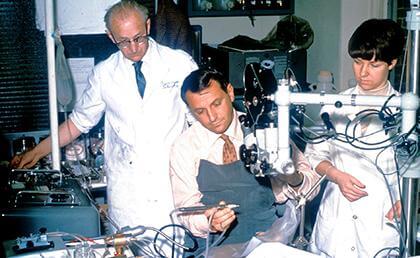By Anna Gustafson
A former Forest Hills doctor who became known as the grandfather of small incision surgeries is the subject of a public television documentary that premiered Wednesday and will be shown in upcoming weeks.
“Through My Eyes: The Charlie Kelman Story” details the life of the ophthalmologist and Forest Hills High School graduate who invented a groundbreaking surgical procedure known as phacoemulsification, which dramatically improved the results of cataract surgery and allowed patients to spend significantly less time in recovery after the procedure.
The documentary, which aired Wednesday at 9 p.m. on WLIW21, “pays homage to the man whose inventions have touched millions of lives worldwide and whose name should be a household name,” according to Roy Hammond, the documentary’s executive producer and former Bayside resident. Encore showings of the piece will be on Jan. 26 at 1 p.m. on WLIW21 and Feb. 6 at 2 p.m. on channel 13.
Prior to the innovations of Kelman, who died at age 74 of lung cancer in 2004, cataract surgery was a complicated and costly procedure that often kept patients in the hospital for eight to 10 days, followed by four to six weeks of recovery at home. Cataract patients then had to wear extremely thick glasses that magnified and distorted individuals’ vision.
Following Kelman’s idea to use a small incision to remove the cataract, however, patients were able to quickly leave the hospital and spend little time recovering.
“In the 1960s, you’d go home and they’d tell you not to move too much, not to exercise, you couldn’t go back to work,” said Charlie’s wife, Ann Kelman. “Today with cataract surgery, you go in the morning, come home in the afternoon and go back to work the next day.”
Kelman first thought of performing cataract surgery using a small incision after a trip to the dentist in the late 1960s, according to Ann Kelman, who also graduated from Forest Hills High School and now lives in Florida.
“He felt there had to be a better way to do cataract surgery so the patient’s quality of life after surgery wasn’t compromised by the surgery,” said Kelman. “People would leave frail and the recovery was lengthy, but he started to work on the idea of doing it with a smaller incision. He kept trying and trying and had that a-ha moment in a dentist chair.”
Kelman’s idea to use a vibrating ultrasonic tip, similar to that which was used by the dentist, to break up the cataract and remove it by suction using a small needle was originally met with skepticism by the mainstream medical society but eventually landed Kelman numerous accolades, Hammond said.
Kelman received the National Medal of Technology and Innovation from former President George H.W. Bush, the American Academy of Ophthalmology’s prestigious Laureate Award and the Lasker Award — the nation’s highest award for medical science.
“When Charlie was first able to remove an unwanted tissue inside the human body through a small hole, he basically became the grandfather of all small incision surgery in the whole body,” said Jack Dodick, chairman of the department of ophthalmology at the New York University Langone Medical Center.
Kelman was a vivacious man who had wanted to be a professional musician before going into medicine, his wife said. His father convinced Kelman to pursue medicine, but he also continued to play saxophone throughout his life and often held concerts for his patients and colleagues.
“If there’s a lesson to be learned from my career, it is while you yourself must steer your ship of success, you must also be able to find others who are willing to fuel it for you,” Kelman said during his 1989 Binkhorst Award lecture given at the American Society of Cataract and Refractive Surgery meeting. “I’ve been exceedingly fortunate to find so many without whom I just might be the saxophone player I only wanted to be.”
Reach reporter Anna Gustafson by e-mail at agustafson@cnglocal.com or by phone at 718-229-0300, Ext. 174.


































